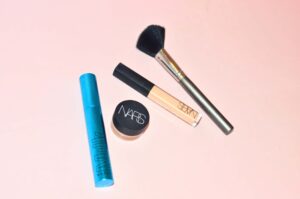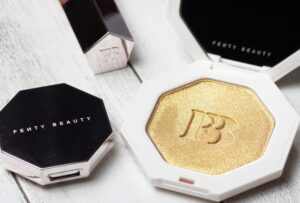Foundation is that revolutionary makeup staple that really acts like a base for other products, allowing them to be seamlessly layered onto the skin. Being this great factor of how good a makeup look is going to end up looking like, it’s best to be familiar with foundation types, foundation makeup purpose, coverage types and so on, so we’ve paid attention to the details, mirroring the seamless application of foundation in your makeup routine.


What is The Purpose of Foundation Makeup?
Foundation, hence the name, serves as the base for face, providing a flawless canvas for the application of various makeup products, including contouring techniques and concealer to address any blemishes or imperfections.
Besides helping on creating an even tone- looking canvas, foundation can also help with covering different levels of imperfections (based on the coverage it provides, as discussed in detail below.)
How Much is Foundation Makeup?
With makeup, the thin is, it always varies. It’s important to know what kind of ingredients you’re after, what kind of skin preferences you have, and if your budget affords picking up the most nutrient-rich makeup products on the market, although you can for sure choose not to splurge and go for dupes instead, while making well-informed decisions.
While high-end foundations can certainly help you achieve your desired makeup look, the beauty market also offers a wide range of drugstore foundations that deliver equally impressive results.
What to Look for in a Foundation?
A foundation which is applied properly should be looking non-streaky, not oxidizing and not flaky, being a canvas-ready for other products to be applied.
Foundation Coverages Types
The basic foundation coverage types are light-to-sheer, medium and full coverage, each delivering different outcomes.
Light-to-Sheer Coverage Foundation
Light-to-sheer coverage foundation provides a subtle hint of warmth to your complexion, perfect for those seeking a natural-looking, less dramatic coverage. Light coverage foundation is great for everyday makeup and really fits the skin needs, allowing it to breathe.
Whenever you think of opting for light coverage foundation, think of tinted moisturizer, as it does the duty very similarly.
With light coverage foundation, you can always build up the coverage and reapply to the desired extent or look.
Medium Coverage Foundation
Medium coverage foundation are great balance of light and full coverage.
This coverage type is perfect for covering up minor imperfections and blemishes, and create a smoother complexion, while still allowing some natural skin texture to show through.
It provides medium coverage with a lightweight and blendable formula for a natural-looking finish.
Full Coverage Foundation
Full coverage foundations are designed to provide maximum coverage and conceal a wide range of skin imperfections, including blemishes, scars, and discoloration.
When using full coverage foundations, it’s important to prep your skin properly with moisturizer and primer to ensure a smooth application and prevent a heavy or cakey look.
Additionally, consider using a beauty blender or brush for blending and achieving a more natural finish.
Foundation Formula Types
Discover the range of five foundation formulas discussed below: liquid, powder, serum, water-based, and cream foundations.
Liquid Foundation
- Liquid foundation most commonly comes in a bottled-packaging. This specific formula of foundation delivers a good coverage and suits those with dry skin best.
- The liquid foundation is best applied in sections and while most liquid formulated foundations are long-lasting, it’s always a good idea to touch the product up throughout the day, and set it with powder for good ‘performance’
Powder Foundation
- Powder foundation comes in powder form, and while it might not provide full coverage formula, it really is the best deal for those with oily skin.
- Powder foundation is convenient for touch-ups, especially in the T-zone or the areas prone to oiliness.
- This foundation formula can be re-applied throughout the day, and as it generally provides lighter coverage, you can easily layer for more coverage if needed. Applying additional layers can help you achieve a higher level of coverage while maintaining a natural finish.
Cream Foundation
- Cream foundations tend to have moisturizing and hydrating ingredients, so they make a great choice for everyone with dry or combination skin.
- This foundation formula comes in a creamy or solid form.
- You can start out with a thin layer and then gradually build up to your desired level of coverage.
- Besides hydration, cream formula foundations can provide dewy, satin finish, adding a natural glow for the skin.
- They are also thicker in consistency when compared to liquid foundations.
Serum Foundation
- Serum foundation makes a great skincare and makeup hybrid, since it is quite skincare-focused while also being a variant of liquid foundation formulas. It typically has a lightweight, fluid texture and offers a natural, radiant finish.
Water-Based foundation
- Water-based foundations, as the name suggests, have water as the primary ingredient in their formulation. They are lightweight, provide a natural finish, and are often preferred by those with oily or combination skin, while usually providing sheer to medium coverage.
- Water-based foundations may have varying degrees of longevity depending on the formulation. Setting them with a translucent powder or using a makeup setting spray can help extend their wear.
- What’s even more important, if you’re aiming for an airbrushed, seamless makeup look it’s always best to match your foundation formula with your makeup primer formula.
Different Foundation Finishes
The term “foundation finish” refers to the overall texture and appearance that makeup, specifically foundation, creates on the skin. It describes how the foundation looks and feels once applied, taking into account factors such as coverage, luminosity, smoothness, and overall effect on the complexion.
There are three primary foundation finishes to choose from: matte, dewy or luminous, and satin or natural finish. Here’s a list of the three foundation formula types and their properties:
1. Matte Finish: Ideal for oily or combination skin types that tend to produce excess oil throughout the day. The matte finish helps control shine and provides a long-lasting, oil-free appearance.
2. Dewy/Luminous Finish: Great for dry or dull skin types that lack natural luminosity. The dewy or luminous finish adds hydration and a radiant glow, giving the skin a healthy and moisturized look.
3. Satin/Natural Finish: Suitable for normal or combination skin types that desire a balanced effect. The satin or natural finish offers a subtle glow without being overly matte or dewy, creating a smooth and even appearance.
Each of these finishes caters to different skin types and preferences, ensuring that you can choose the one that best suits your specific needs and desired effect.
From knowing the purpose and coverage options to exploring different formulas and finishes, this comprehensive guide has provided valuable insights into choosing the right foundation for your needs.
With this knowledge, you can confidently create a smooth and beautiful canvas for your makeup and enhance your overall appearance.
Related: How to Apply Highlighter for Beginners and Where to Place It?
FAQs
Is Foundation Necessary for Makeup?
Foundation is a versatile tool in the world of makeup, but it’s not a mandatory step. Whether or not you need foundation depends on your personal preference and the desired outcome of your makeup look. It’s all about finding what works for you and your skin.
Foundation is typically used to create a smooth, even-toned base and provide a canvas for other makeup products. It helps minimize the appearance of imperfections, discoloration, and blemishes. However, if you have clear and even skin, you might feel confident skipping foundation altogether or opting for lighter alternatives like tinted moisturizers, BB creams, or CC creams.
How to Remove Foundation Without Makeup Remover?
Check out these quick and effective methods that will leave help you remove foundation without makeup remover:
- Double Cleanse with Oil: Massage natural oils like coconut, almond, or olive oil onto your face to dissolve foundation. Wipe it off using a soft cloth or cotton pads.
- Micellar Water Magic: Opt for micellar water, a fantastic alternative to makeup remover. Soak a cotton pad and gently swipe away foundation for a clean complexion.
- Gentle Cleansing Milk: If you have cleansing milk or cream cleanser, apply it generously and massage it in circular motions. Rinse with warm water or use a damp cloth to wipe away both cleanser and foundation.
- Warm Water and Face Cloth: In a pinch, warm water and a face cloth work wonders. Press the warm cloth onto your skin to soften the foundation, then gently wipe it away.
Remember to be gentle and follow up with your regular skincare routine.
How to Fix Cracked Foundation Makeup?
When dealing with cracked foundation makeup, there are a few steps you can take to fix it. Firstly, ensure your skin is moisturized before applying foundation. Then, gently blend a small amount of foundation over the cracked areas, using tapping motions. If needed, use a makeup sponge to blend the edges. Finish with a light dusting of setting powder for a seamless look.
What is Sheer Foundation Makeup?
Sheer foundation refers to a specific type of foundation formula. It is designed to have a lightweight texture and provide a sheer, translucent coverage. Sheer foundations typically have a thinner consistency compared to medium or full coverage foundations, allowing your skin’s natural beauty to show through while still providing some evening out of the skin tone.
Perfect for a minimalistic approach, sheer foundation is lightweight, blends easily, and suits various skin types.



